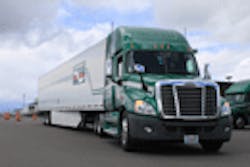California GHG compliance could save carriers money over time
Despite the costs of complying with the California Air Resources Board’s (CARB) new heavy-duty tractor-trailer greenhouse gas (GHG) regulation mandate that went into effect Jan. 1 this year, some fleets are finding they may come out ahead in the long run. (Read more CARB news from FleetOwner)
For example, Tacoma, WA-based Interstate Distributor Co. says the fuel efficiency gains it’s achieving via new aerodynamic side fairings on its trailers should more than outweigh the cost of installation within a relatively short time frame.
In a conference call with reporters, Lee Owens, Interstate’s senior vice president of maintenance and facilities, said the company tested trailer side skirts for the past few years, achieving between a 3 and 5% improvement in fuel economy, depending upon the route and the speed its units travelled.
“And that 3 to 5% range is very conservative,” Owens stressed. “Basically, with that kind of efficiency gain, we’d have installed side fairings on our trailers whether they were mandated or not. The benefits are too big to ignore.”
Interstate operates a fleet of more than 2,000 tractors and 6,800 trailers and is currently installing Aeroflex side skirts from Seattle-based Freight Wing on 2,058 of its trailers. The carrier is getting the cost of installation partially offset via a $175,000 grant from the Pacific Northwest Pollution Prevention Resource Center (PPRC).
The PRRC obtained that money, in turn, from a $875,972 grant from the Environmental Protection Agency’s (EPA) Diesel Emissions Reduction Act (DERA).
All told, Intertsate’s Owens said that without the EPA grant, Interstate would be seeing a return on investment of less than two years. With the grant, the time is cut by a third.
According to PPRC, Interstate’s trailer fairing project is expected to save 1.1 million gallons of diesel a year, over 16 million gallons over the lifespan of the skirts, while preventing the emission of 182,633 tons of GHGs.
Those fuel savings should more than help offset the costs associated with installing trailer side fairings. CARB, for example, estimates the average cost of trailer compliance with its new mandate – which governs 53-ft. or longer box-type trailers operating in California – at around $2,900 per trailer.
Yet if fleets achieve gains of 7 to 10% in fuel economy with such devices, CARB figures they’d save $4,000 to $5,700 per year per tractor-trailer combination.
Indeed, Sean Graham, president of Freight Wing, said his company’s product registered fuel economy savings of up to 7% in independent SAE/TMC J1321 track testing conducted by Energotest two years ago. At that level of fuel economy savings, in his analysis, a fleet would be able to pay off its investment in trailer side fairings after roughly 50,000 mi. of operation.
“Now, track tests are done in a controlled environment at constant highway speeds, so in the real world, results can vary due to different average speeds, applications and driving environments,” Graham noted. “However, fleets and owner-operators typically see anywhere from 4 to 7% improvements, with high mileage applications getting the best results.”
About the Author
Sean Kilcarr
Editor in Chief
Sean Kilcarr is a former longtime FleetOwner senior editor who wrote for the publication from 2000 to 2018. He served as editor-in-chief from 2017 to 2018.
